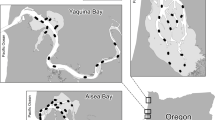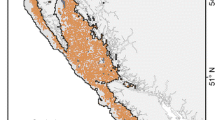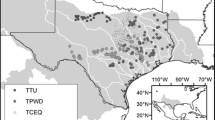Abstract
Intertidal crabs are abundant in tropical estuaries and have bio-indicator potential. However, the use of intertidal crabs in guiding management actions is limited because high-replication, cost-effective tools to analyze their distribution patterns at large scales are lacking. This study used assemblage modeling and photography to rapidly build formal understanding of the spatial organization of crab communities in the low intertidal zone, between mean sea level at low spring tide and the edge of the mangrove forest, within and among estuaries. A classification and regression tree model revealed seven distinct habitats based on relative occurrence of five species (Uca coarctata, Uca seismella, Macrophthalmus japonicus, Metopograpsus frontalis, and Metopograpsus latifrons) among eight estuaries along 160 km of coast in North Queensland, Australia (18° 28′–19° 25′ S, 146° 12′–147° 14′ E), across four sampling trips between April 2009 and October 2010. Photography provided high-replication sampling across a large area relative to the aim of the study but did not represent the whole intertidal crab community. Complementary hand collections within one estuary allowed the occurrences of three other species (Perisesarma longicristatum, Australoplax tridentata, and Metopograpsus thukuhar) to be fitted into the model. Species occurred across habitats, yet a high occurrence of different species characterized each habitat. The presence of some species not usually found on low intertidal banks suggested connectivity across the intertidal landscape. The model provided a formal basis to add previous small “site or transect specific” scale spatial distribution knowledge as well as other ecological information. Areas with outlying values can be identified as research and management priorities in the absence of other information, although this prioritization should be done with care. The approach may be transferable to other organisms and systems to provide rapid, cost-effective information on the distribution of key fauna where background understanding and resources are limited.




Similar content being viewed by others
References
Alongi, D.M. 2002. Present state and future of the world’s mangrove forests. Environmental Conservation 29: 331–349.
Alongi, D.M. 2008. Mangrove forests: resilience, protection from tsunamis, and responses to global climate change. Estuarine, Coastal and Shelf Science 76: 1–13.
Ashton, E.C., P.J. Hogarth, and D.J. Macintosh. 2003. A comparison of Brachyuran crab community structure at four mangrove locations under different management systems along the Melaka Straits-Andaman Sea coast of Malaysia and Thailand. Estuaries 26: 1461–1471.
Bartolini, F., G. Penha-Lopes, S. Limbu, J. Paula, and S. Cannicci. 2009. Behavioural responses of the mangrove fiddler crab (Uca annulipes and U. inversa) to urban sewage loadings: results of a mesocosm approach. Marine Pollution Bulletin 58: 1860–1867.
Bezerra, L.E.A., C.B. Dias, G.X. Santana, and H. Matthews-Cascon. 2006. Spatial distribution of fiddler crabs (genus Uca) in a tropical mangrove of northeast Brazil. Scientia Marina 70: 759–766.
Blakeway, D.R., C.D. Robles, D.A. Fuentes, H. Qiu. 2004. Spatially extensive, high resolution images of rocky shore communities. In: Handbook of scaling methods in aquatic ecology, ed. L. Seruont, and P.G. Strutton, 109–124 CRC Press.
Booksmythe, I., T. Detto, and P.R.Y. Backwell. 2008. A field guide to the fiddler crabs of east point reserve, Darwin, Northern Territory. Northern Territory Naturalist 20: 26–33.
Botto, F., G. Palomo, O. Iribarne, and M. Martinez. 2000. The effect of Southwestern Atlantic burrowing crabs on habitat use and foraging activity of migratory shorebirds. Estuaries 23: 208–215.
Bouillon, S., N. Koedam, A.V. Raman, and F. Dehairs. 2002. Primary producers sustaining macro-invertebrate communities in intertidal mangrove forests. Oecologia 130: 441–448.
Bui, T.H.H., and S.Y. Lee. 2014. Does you are what you eat apply to mangrove grapsid crabs? PloS One 9: e89074.
Bureau of Meteorology Australian Government. 2009. Climate Data Online. www.bom.gov.au/climate/data. Accessed 1 Sept 2013.
Cannicci, S., S. Ritossa, R.K. Ruwa, and M. Vannini. 1996a. Tree fidelity and hole fidelity in the tree crab Sesarma leptosoma (Decapoda, Grapsidae). Journal of Experimental Marine Biology and Ecology 196: 299–311.
Cannicci, S., F. Dahdouh-Guebas, D. Anyona, and M. Vannini. 1996b. Natural diet and feeding habits of Thalamita crenata (Decapoda: Portunidae). Journal of Crustacean Biology 16: 678–683.
Cannicci, S., R.K. Ruwa, M. Giuggioli, and M. Vannini. 1998. Predatory activity and spatial strategies of Epixnathus dentatus (Decapoda: Oziidae), an ambush predator among the mangroves. Journal of Crustacean Biology 18: 57–63.
Cannicci, S., S. Fratini, and M. Vannini. 1999a. Use of time, space and food resources in the mangrove climbing crab Selatium elongatum (Grapsidae, Sesarmidae). Marine Biology 135: 335–339.
Cannicci, S., J. Paula, and M. Vannini. 1999b. Activity pattern and spatial strategy in Pachygrapsus marmoratus (Decapoda: Grapsidae) from Mediterranean and Atlantic shores. Marine Biology 133: 429–435.
Cannicci, S., F. Bartolini, F. Dahdouh-Guebas, S. Fratini, C. Litulo, A. Macia, E.J. Mrabu, G. Penha-Lopes, and J. Paula. 2009. Effects of urban wastewater on crab and mollusc assemblages in equatorial and subtropical mangroves of East Africa. Estuarine, Coastal and Shelf Science 84: 305–317.
Castiglioni, D.D.S., and M.L. Negreiros-Fransozo. 2005. Comparative population biology of Uca rapax (Smith, 1870) (Brachyura, Ocypodidae) from two subtropical mangrove habitats on the Brazilian coast. Journal of Natural History 39: 1627–1640.
Christofoletti, R.A., G.Y. Hattori, and M.A.A. Pinheiro. 2013. Food selection by a mangrove crab: temporal changes in fasted animals. Hydrobiologia 702: 63–72.
Colby, D.R., and M.S. Fonseca. 1984. Population dynamics, spatial dispersion and somatic growth of the sand fiddler crab Uca pugilator. Marine Ecology Progress Series 16: 269–279.
Costanza, R., R. D’Arge, R. de Groot, S. Farberk, M. Grazzo, B. Hannon, K. Limburg, S. Naeem, R.V. O’Neill, J. Paruelo, R.G. Raskin, P. Sutton, and M. van den Belt. 1997. The value of the world’s ecosystem services and natural capital. Nature 387: 253–260.
Dahdouh-Guebas, F., M. Verneirt, S. Cannicci, J.G. Kairo, J.F. Tack, and N. Koedam. 2002. An exploratory study on grapsid crab zonation in Kenyan mangroves. Wetlands Ecology and Management 10: 179–187.
De’ath, G. 2002. Multivariate regression trees: a new technique for modeling species-environment relationships. Ecology 83: 1105–1117.
De’ath, G., and K.E. Fabricius. 2000. Classification and regression trees: a powerful yet simple technique for ecological data analysis. Ecology 81: 3178–3192.
Decoursey, D.G. 1992. Developing models with more detail: do more algorithms give more truth? Weed Technology 6: 709–715.
Defeo, O., and A. McLachlan. 2011. Coupling between macrofauna community structure and beach type: a deconstructive meta-analysis. Marine Ecology Progress Series 433: 29–41.
Diele, K., V. Koch, and U. Saint-Paul. 2005. Population structure, catch composition and CPUE of the artisanally harvested mangrove crab Ucides cordatus (Ocypodidae) in the Caeté estuary, North Brazil: indications for overfishing? Aquatic Living Resources 18: 169–178.
Dittmann, S. 2002. Benthic fauna in tropical tidal flats of Hinchinbrook Channel, NE Australia: diversity, abundance and their spatial and temporal variation. Wetlands Ecology and Management 10: 323–333.
Duke, N.C., J.O. Meynecke, S. Dittmann, A.M. Ellison, K. Anger, U. Berger, S. Cannicci, K. Diele, K.C. Ewel, C.D. Field, N. Koedam, S.Y. Lee, C. Marchand, I. Nordhaus, and F. Dahdouh-Guebas. 2007. A world without mangroves. Science 317: 41–42.
Eshky, A.A., R.J.A. Atkinson, and A.C. Taylor. 1995. Physiological ecology of crabs from Saudi Arabian mangrove. Marine Ecology Progress Series 126: 83–95.
Fensham, R.J., and R.J. Fairfax. 2002. Aerial photography for assessing vegetation change: a review of applications and the relevance of findings for Australian vegetation history. Australian Journal of Botany 50: 415–429.
Ferreira, A.C., G. Ganade, F.A. Morais Freire, and J.L. Attayde. 2013. Propagule predation in a Neotropical mangrove: the role of the grapsid crab Goniopsis cruentata. Hydrobiologia 707: 135–146.
Fitch, J.E., and T.P. Crowe. 2010. Effective methods for assessing ecological quality in intertidal soft-sediment habitats. Marine Pollution Bulletin 60: 1726–1733.
Fransworth, E.J., and A.M. Ellison. 1996. Scale-dependent spatial and temporal variability in biogeography of mangrove root epibiont communities. Ecological Monographs 66: 45–66.
Frusher, S.D. 1988. Key to crabs associated with mangroves in North Queensland, vol. 1. Australia: Australian Institute of Marine Science.
Frusher, S.D., R.L. Giddins, and T.J. Smith. 1994. Distribution and abundance of grapsid crabs (Grapsidae) in a mangrove estuary: effects of sediment characteristics, salinity tolerances, and osmoregulatory ability. Estuaries 17: 647–654.
George, R.W., and D.S. Jones. 1982. A revision of the fiddler crabs of Australia (Ocypodinae: Uca). Records of the Western Australian Museum suppl. no. 14
Gleason, H.A. 1926. The individualistic concept of plant association. Bulletin of the Torrey Botanical Club 53: 1–20.
Guest, M.A., R.M. Connolly, S.Y. Lee, N.R. Loneragan, and M.J. Breitfuss. 2006. Mechanism for the small-scale movement of carbon among estuarine habitats: organic matter transfer not crab movement. Oecologia 148: 88–96.
Guisan, A., and N.E. Zimmermann. 2000. Predictive habitat distribution models in ecology. Ecological Modelling 135: 147–186.
Hartnoll, R.G., S. Cannici, W.D. Emmerson, S. Fratini, A. Macia, Y. Mgaya, F. Porri, R.K. Ruwa, J.P. Shunula, and M.W. Skov. 2002. Geographic trends in mangrove crab abundance in East Africa. Wetlands Ecology and Management 10: 203–213.
Hemmi, J.M., J. Marshall, W. Pix, M. Vorobyev, and J. Zeil. 2006. The variable colours of the fiddler crab Uca vomeris and their relation to background and predation. The Journal of Experimental Biology 409: 4140–4153.
How, M.J., J.M. Hemmi, J. Zeil, and R. Peters. 2008. Claw waving display changes with receiver distance in fiddler crabs, Uca perplexa. Animal Behaviour 75: 1015–1022.
Icely, J.D., and D.A. Jones. 1978. Factors affecting the distribution of the genus Uca (Crustacea: Ocypodidae) on an East African shore. Estuarine and Coastal Marine Science 6: 315–325.
Jordão, J.M., and R.F. Oliveira. 2003. Comparison of non-invasive methods for quantifying population density of the fiddler crab Uca tangeri. Journal of the Marine Biological Association of the UK 83: 981–982.
Kanaya, G., S. Takagi, and E. Kikuchi. 2008. Dietary contribution of the microphytobenthos to infaunal deposit feeders in an estuarine mudflat in Japan. Marine Biology 155: 543–553.
Koch, V., M. Wolff, and K. Diele. 2005. Comparative population dynamics of four fiddler crabs (Ocypodidae, genus Uca) from a North Brazilian mangrove ecosystem. Marine Ecology Progress Series 291: 177–188.
Kon, K., Y. Hoshino, K. Kanou, D. Okazaki, S. Nakayama, and H. Kohno. 2012. Importance of allochthonous material in benthic macrofaunal community functioning in estuarine salt marshes. Estuarine, Coastal and Shelf Science 96: 236–244.
Korzukhin, M.D., M.T. Ter-Mikaelian, and G.M. Wagner. 1996. Process versus empirical models: which approach for forest ecosystem management? Canadian Journal of Forest Research 26: 879–887.
Kristensen, E. 2008. Mangrove crabs as ecosystem engineers; with emphasis on sediment processes. Journal of Sea Research 59: 30–43.
Kyomo, J. 1986. Reproductive activities in the sesarmid crab Sesarma intermedia in the coastal and estuarine habitats of Hakata, Japan. Marine Biology 91: 319–329.
Lee, S., and P.W. Kwok. 2002. The importance of mangrove species association to the population biology of the sesarmine crabs Parasesarma affinis and Perisesarma bidens. Wetlands Ecology and Management 10: 215–226.
Lee, S.Y. 1998. Ecological role of grapsid crabs in mangrove ecosystems: a review. Marine and Freshwater Research 49: 335–343.
Lee, S.Y. 2008. Mangrove macrobenthos: assemblages, services, and linkages. Journal of Sea Research 59: 16–29.
Lee, S.Y., R.J.K. Dunn, R.A. Young, R.M. Connolly, R.E.R. Dale, R. Dehayr, C.J. Lemckert, S. McKinnon, B. Powell, P.R. Teasdale, and D.T. Welsh. 2006. Impact of urbanization on coastal wetland structure and function. Australian Ecology 31: 149–163.
Lewis, T.L., M.J. Mews, D.E. Jelinski, and M. Zimmer. 2007. Detrital subsidy to the supratidal zone provides feeding habitat for intertidal crabs. Estuaries and Coasts 30: 451–458.
Lim, S., and S. Kalpana. 2011. Maxilliped-setation adaptations to habitat and sexual dimorphism of feeding claws in Uca perplexa and U. vomeris. Journal of Crustacean Biology 31: 406–412.
MacFarlane, G.R., D.J. Booth, and K.R. Brown. 2000. The Semaphore crab, Heloecius cordiformis: bio-indication potential for heavy metals in estuarine systems. Aquatic Toxicology 50: 153–166.
Macintosh, D.J., E.C. Ashton, and S. Havanon. 2002. Mangrove rehabilitation and intertidal biodiversity: a study in the Ranong mangrove ecosystem, Thailand. Estuarine, Coastal and Shelf Science 55: 331–345.
Magurran, A.E., S.R. Baillie, S.T. Buckland, J.M. Dick, D.A. Elston, E.M. Scott, R.I. Smith, P.J. Sommerfield, and A.D. Watt. 2010. Long-term datasets in biodiversity research and monitoring: assessing change in ecological communities through time. Trends in Ecology & Evolution 25: 574–582.
McDonald-Madden, E., P.W.J. Baxter, R.A. Fuller, T.G. Martin, E.T. Game, J. Montambault, and H.P. Possingham. 2010. Monitoring does not always count. Trends in Ecology & Evolution 25: 547–550.
Meziane, T., M.C. Sanabe, and M. Tsuchiya. 2002. Role of fiddler crabs of a subtropical intertidal flat on the fate of sedimentary fatty acids. Journal of Experimental Marine Biology and Ecology 270: 191–201.
Micheli, F., F. Gherardi, and M. Vannini. 1991. Feeding and burrowing ecology of two East African mangrove crabs. Marine Biology 111: 247–254.
Moilanen, A., J.R. Leathwick, and J.M. Quinn. 2011. Spatial prioritization of conservation management. Conservation Letters 4: 383–393.
Moss, A., J. Brodie, and M. Furnas. 2005. Water quality guidelines for the Great Barrier Reef World Heritage Area: a basis for development and preliminary values. Marine Pollution Bulletin 51: 76–88.
Nagelkerken, I., S.J.M. Blaber, S. Bouillon, P. Green, M. Haywood, L.G. Kirton, J.O. Meynecke, J. Pawlik, H.M. Penrose, A. Sasekumar, and P.J. Somerfield. 2008. The habitat function of mangroves for terrestrial and marine fauna: a review. Aquatic Botany 89: 155–185.
Ng, P.K.L., D. Guinot, and P.J.F. Davie. 2008. Systema Brachyurorum: part I. An annotated checklist of extant Brachyuran crabs of the world. The Raffles Bulletin of Zoology 17: 1–286.
Nobbs, M. 2003. Effects of vegetation differ among three species of fiddler crabs (Uca spp.). Journal of Experimental Marine Biology and Ecology 284: 41–50.
Nobbs, M., and K.A. McGuinness. 1999. Developing methods for quantifying the apparent abundance of fiddler crabs (Ocypodidae: Uca) in mangrove habitats. Australian Journal of Ecology 24: 43–49.
Nordhaus, I., F.A. Hadipudjana, R. Janssen, and J. Pamungkas. 2009. Spatio-temporal variation of macrobenthic communities in the mangrove-fringed Segara Anakan lagoon, Indonesia, affected by anthropogenic activities. Regional Environmental Change 9: 291–313.
Penha-Lopes, G., F. Bartolini, S. Limbu, S. Cannicci, E. Kristensen, and J. Paula. 2009. Are fiddler crabs potentially useful ecosystem engineers in mangrove wastewater wetlands? Marine Pollution Bulletin 58: 1694–1703.
Poon, D.Y.N., B.K.K. Chan, and G.A. Williams. 2010. Spatial and temporal variation in diets of the crabs Metopograpsus frontalis (Grapsidae) and Perisesarma bidens (Sesarmidae): implications for mangrove food webs. Hydrobiologia 638: 29–40.
Rodriguez, E.M., D.A. Medesani, and M. Fingerman. 2007. Endocrine disruption in crustaceans due to pollutants: a review. Comparative Biochemistry and Physiology 146: 661–671.
Ronnback, P. 1999. The ecological basis for economic value of seafood production supported by mangrove ecosystems. Ecological Economics 29: 235–252.
Salgado Kent, S.P., and K.A. McGuinness. 2006. A comparison of methods for estimating relative abundance of grapsid crabs. Wetlands Ecology and Management 14: 1–9.
Seto, K.C. 2011. Exploring the dynamics of migration to mega-delta cities in Asia and Africa: contemporary drivers and future scenario. Global Environmental Change 21S: 94–107.
Shaw, M., and I.R. Tibbetts. 2004. Grazing by Metopograpsus frontalis (Decapoda: Grapsidae) on intertidal rock walls of Moreton Bay. Proceedings of the Royal Society of Queensland 111: 95–101.
Sheaves, M., and R. Johnston. 2010. Implications of spatial variability of fish assemblages for monitoring of Australia’s tropical estuaries. Aquatic Conservation 20: 348–356.
Sheaves, M., and B. Molony. 2000. Short-circuit in the mangrove food chain. Marine Ecology Progress Series 199: 97–109.
Sheaves, M., R. Johnston, B. Molony, and G. Shepard. 2007. The effect of impoundments on the structure and function of fish fauna in a highly regulated dry tropical estuary. Estuaries and Coasts 30: 507–517.
Silva, A.C.F., S.J. Hawkins, D.M. Boaventura, E. Brewster, and R.C. Thompson. 2010. Use of the intertidal zone by mobile predators: influence of wave exposure, tidal phase and elevation on abundance and diet. Marine Ecology Progress Series 406: 197–210.
Sivasothi, N. 2000. Niche preferences of tree-climbing crabs in Singapore mangroves. Crustaceana 73: 25–38.
Solan, M., J.D. Germano, D.C. Rhoads, C. Smith, E. Michaud, D. Parry, R. Wenzhofer, B. Kennedy, C. Henriques, E. Battle, D. Carey, L. Iocco, R. Valente, J. Watson, and R. Rosenberg. 2003. Towards a greater understanding of pattern, scale and process in marine benthic systems: a picture is worth a thousand worms. Journal of Experimental Marine Biology and Ecology 285–286: 313–338.
Takeda, S. 2010. Habitat partitioning between prey soldier crab Mictyris brevidactylus and predator fiddler crabs Uca perplexa. Journal of Experimental Marine Biology and Ecology 390: 160–168.
Vermeiren, P., and M. Sheaves. 2014a. A remote photographic technique for high replication, large scale understanding of spatial distribution patterns of intertidal crabs. Hydrobiologia 724: 79–89.
Vermeiren, P., and M. Sheaves. 2014b. Predictable habitat associations of four crab species across the low intertidal landscape of a tropical estuary over time. Estuaries and Coasts. doi:10.1007/s12237-014-9799-0.
Vermeiren, P., and M. Sheaves. 2014c. Predicting habitat associations of five intertidal crab species among estuaries. Estuarine, Coastal and Shelf Science. doi:10.1016/j.ecss.2014.08.008.
Wentworth, C.K. 1922. A scale of grade and class terms for clastic sediments. Journal of Geology 30: 377–392.
Werry, J., and S.Y. Lee. 2005. Grapsid crabs mediate link between mangrove litter production and estuarine planktonic food chains. Marine Ecology Progress Series 293: 165–176.
Whittaker, R.H. 1975. Communities and ecosystems, 2nd ed. New York: Macmillan.
Wolff, M., V. Koch, and V. Isaac. 2000. A trophic flow model of the Caeté mangrove estuary (North Brazil) with considerations for the sustainable use of its resources. Estuarine, Coastal and Shelf Science 50: 786–803.
Yamaguchi, T. 2002. Survival rate and age estimation of the fiddler crab, Uca lactea (De Haan, 1835) (Decapoda, Brachyura, Ocypodidae). Crustaceana 75: 993–1014.
Yamaguchi, T., and T. Sugakiri. 2005. Territory usage and defence of the fiddler crab, Uca lactea (De Haan) (Decapoda, Brachyura, Ocypodidae). Crustaceana 77: 1055–1080.
Zeil, J., and J.M. Hemmi. 2006. The visual ecology of fiddler crabs. Journal of Comparative Physiology 192: 1–25.
Zeil, J., and M. Hofmann. 2001. Signals from “crabworld”: cuticular reflections in a fiddler crab colony. Journal of Experimental Marine Biology and Ecology 204: 2561–2569.
Acknowledgments
The authors are pleased to acknowledge members of the Estuary and Tidal Wetland Ecosystems Research Group, students from James Cook University, and personal friends for their assistance in the collection of data in the field.
Author information
Authors and Affiliations
Corresponding author
Additional information
Communicated by Judy Grassle
Rights and permissions
About this article
Cite this article
Vermeiren, P., Sheaves, M. Modeling Intertidal Crab Distribution Patterns Using Photographic Mapping Among Tropical Australian Estuaries. Estuaries and Coasts 38, 1545–1556 (2015). https://doi.org/10.1007/s12237-014-9897-z
Received:
Revised:
Accepted:
Published:
Issue Date:
DOI: https://doi.org/10.1007/s12237-014-9897-z




